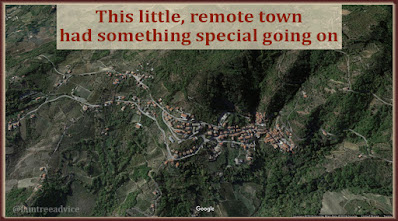You already have the materials to make this most personal gift for someone you love.
Have you been watching Henry Louis Gates, Jr.'s "Finding Your Roots" on PBS? It's bursting with the type of excitement that keeps us active in genealogy year after year.
I've always liked the "book of life" he gives to each guest. You and I may be used to reading census sheets and ship manifests. But for the TV show's guests, it's probably the first time they've seen such a thing.
My mom's 1st cousin Eleanor had a milestone birthday last week. Years ago I printed a family tree that measured 2 feet by 4 feet. I made 40 copies and gave them to the heads of 40 families. Eleanor is the only one who put hers up on a wall and looks at it regularly.
Eleanor is the perfect cousin to get a "book of life" from me. You must have relatives who would appreciate a gift like this, too.
Here's how I created the book for my cousin.
1. See What You Have
My research hasn't gotten very far on Eleanor's father's side of the family. But I do have his ship manifest showing his arrival in America. I have his father's draft registration card, ship manifest, and census sheets.
Eleanor's mother was my great aunt. I've taken her tree back many generations. I have her beautiful wedding portrait and a copy of her marriage certificate.
All these items are good material for the book. I even had an extra 1-inch binder and lots of clear sleeves to hold as many pages as I wanted. If I didn't have the binder, I'd have looked for ideas in a local stationery store.
 |
| Use up the entire sheet of paper by toying with your print options. |
2. Print the Best Documents
Print the different census sheets, manifests, and certificates onto 8½" x 11" paper. It's nice to see them and hold them at this size when you're used to seeing them only on your computer screen.
I have a laser printer that does an excellent job of printing documents. If your ink-jet or other type of printer isn't doing justice to the documents, put the files on a flash drive. Find a friend with a better printer or go to a store like Staples or the UPS Store that can print the images for you.
3. Create "Call-Outs" to Make it Easy to Follow
You and I know how to find the right line on a census or manifest and understand the information. But your cousin doesn't.
There are 2 things you can do to help:
- Use your photo-editing software to carve out the important lines on the document. Blow them up a bit bigger and print them out. Place the enlarged cut-outs on top of the document. I put a little rolled-up bit of tape on the back of the cut-out to attach it to the document.
- Create a text box in your word processing software with nice big letters. Explain what we're looking at. For example, I made a text box to attach to a draft registration card that says:
Carlo Vallone's World War I draft registration card, Sept. 12, 1918
Address: 239 E. 151st St., Bronx, New York
Birth: Dec. 8, 1881 in Italy
Job: elevated conductor for the IRT
 |
| Enlarge and summarize the most important information. |
I printed these call-outs on marigold-colored paper. I included a thick outline for each call-out to help it stand out.
4. Put it in a Scrapbook or Binder
Some documents, like ship manifests, often have 2 pages. When you're putting your printouts into the book, be sure to arrange them so you can see both pages at once. When you're creating a family tree for the book, try to size it to 2 pages, and arrange them on facing pages in the book.
 |
| Make sure 2-page documents can be seen together. |
My binder had an extra pocket in the back. I decided to print an extended family tree and fold it down to fit in the pocket. I started with Eleanor's mother and siblings and went up 6 generations. I included dates and places of birth, marriage, and death.
I sized this tree to fit on 9 sheets of paper. Then I printed it out, trimmed the pages, taped them together from the back, and folded it down neatly. For instructions on how to put together a multi-page document like this, see "This Project Makes Your Family History Larger than Life".
I didn't get to see Eleanor open her "book of life", but she did tell me how much it means to her.
How often do you have the chance to give such a unique and personal gift? Check your calendar. Is there a birthday coming up for a relative who would love their own "book of life"?




